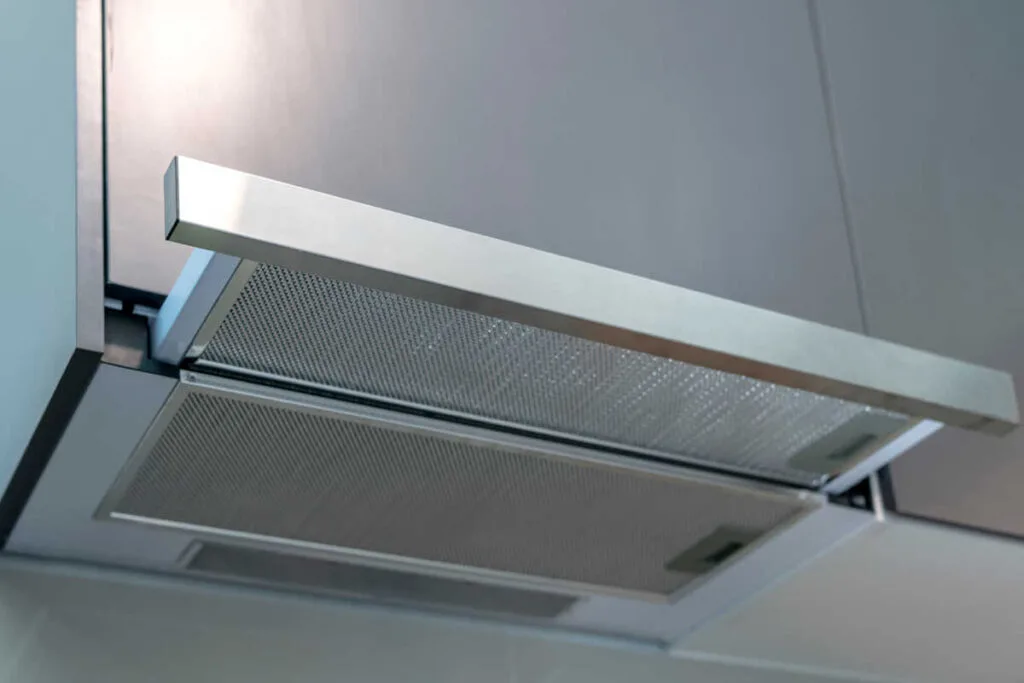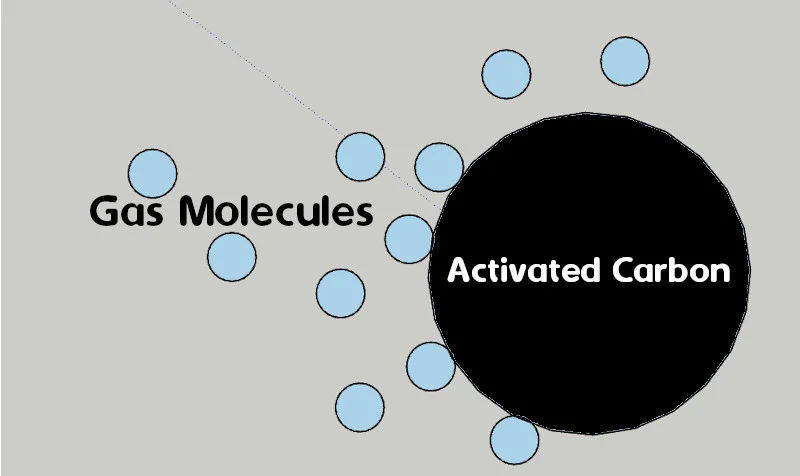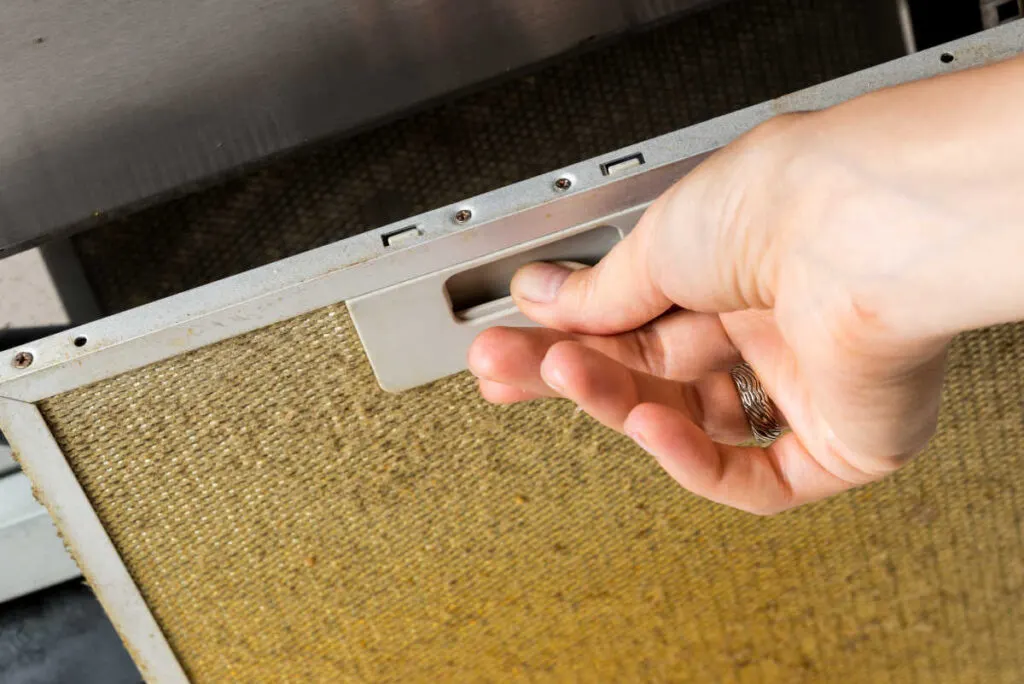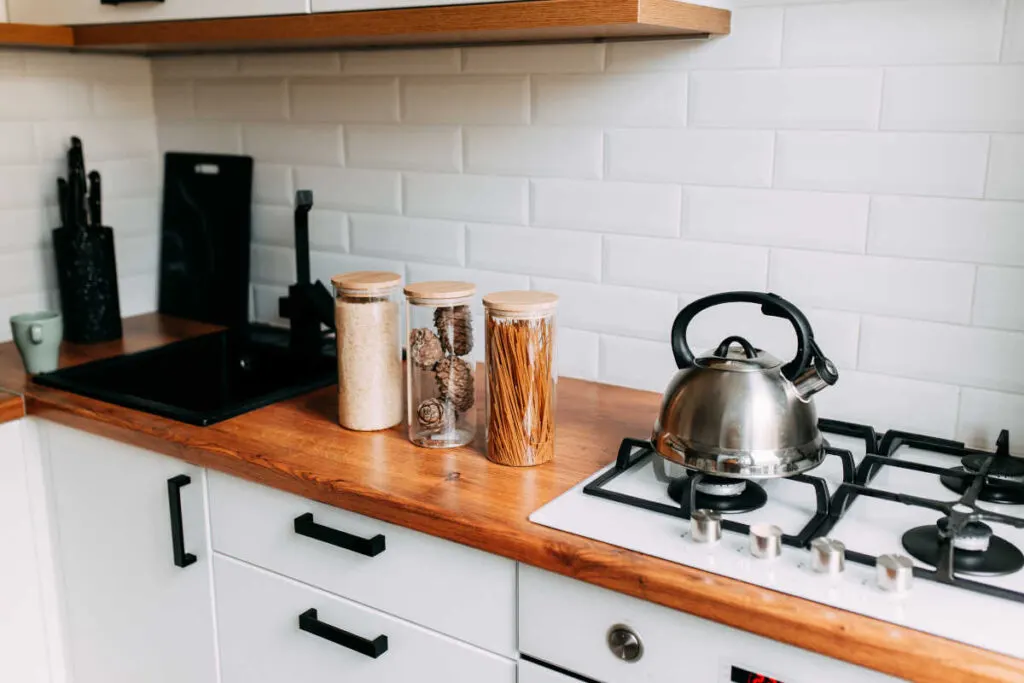
The topic of kitchen ventilation comes up often when cooking something with a strong smell. Most modern kitchens have some type of range hood installed.
If your kitchen lacks a range hood, keep reading to find out if it is worth it to install a ductless range hood.
Range hoods come in two types; ducted and ductless.
A Ductless range hood is much better than having no ventilation at all. A ductless range hood circulates air through an activated carbon filter and a fat filter. The former traps some of the odors and gases and the latter traps airborne fat.
Theoretically, ductless range hoods should work perfectly. Think of gas masks. They also use carbon filters and make toxic air breathable.
However, there are a couple of problems why range hoods don’t filter air as effectively. I will discuss the reasons in later paragraphs.
Do Recirculating Range Hoods Really Work
Ductless range hoods also called recirculating range hoods do, in fact, work, but only up to a certain extent. They effectively filter out small amounts of smoke and cooking odors. Ductless range hoods do not filter out steam, as this is impossible.
In order for steam to be removed, it has to either be exhausted out of the building or condensed and then collected. This is how a dehumidifier works. No type of filter can remove moisture/steam.
Related article : Are Range Hoods Necessary
Recirculating range hoods are not suitable for cooking techniques that produce large amounts of smoke, such as stir-frying. If you do however seldom stir fry they may still work well for you, since you could open up a window whenever you cook something that smokes a lot.
Ductless hoods however effectively eliminate general cooking smells, for example when boiling or pan-frying something at a low temperature where a small amount of smoke is produced.
As you can see, ductless range hoods do have their limits. Especially the convertible types. (more on that later).
However, when installing a duct for a conventional range hood is impractical. For example it would be very difficult and expensive to install a duct in a finished kitchen that is positioned on the first floor in the middle of the room. In that case a ductless range hood is a great alternative to havin nothing at all.
The efficiency of a ductless range hood really depends on the model of the range hood. Some use ridiculously small filters with very little surface area to trap contaminants.
In order for the carbon filter to be effective, the air must spend some time in the filter. This is known as dwell time. The longer the air spends in the filter the more pollutants will be trapped.
This is why it is total nonsense to buy an ultra-high CFM range hood. It will not make any difference if the air is circulated at a rate of 600 or 300 cubic feet per second through the filter.
What matters is the size and quality of the carbon filter. Filtrating double the amount of air through the filter will not increase the dwell time.
This is why CFM is quite irrelevant when it comes to ductless range hoods. It is much more important to concentrate on filter size and replacement filter cost when choosing a ductless range hood. This is what ultimately makes 80% of the difference.
Related Article: 8 Reasons Why A Range Hood Is not Effective
On a side note; CFM is very important for conventional ducted range hoods.
How A Ductless Range Hood Works
A ductless range hood works by circulating air through an activated carbon filter. The carbon filter will adsorb the odor molecules. See the illustration below.

To compare, particle filters such as HEPA work by absorbing the particles, like a sponge. This is completely different compared to what an activated carbon filter does.
Adsorbing means that the molecules will be diffused on the surface of the carbon. As the molecule moves through the filter it will hit the wall of the filter and get stuck.
As you can probably figure out yourself, increasing CFM will not help with adsorption. Increasing the airflow will dramatically increase the speed at which the air molecules move through the filter, although this will not improve filter efficiency. The efficiency is limited by the filter’s capacity to diffuse molecules, not by the airflow.
As air is circulated through the filter organic gas molecules, in this case, food odors and gases are trapped on the carbon. As the filter becomes saturated with molecules it becomes less effective. Because the molecule can only stick somewhere where there is an empty spot.
Related Article: Does a Range Hood Need to Be Grounded
Since the surface area of a carbon filter is huge, there is a lot of room for the gases to settle. One gram of activated carbon can have a surface area of up to 20 000 square feet.
After about half of the surface area is saturated the filter should be replaced.
This is why I recommended a range hood with a large filter. This will improve the efficiency of the range hood, and increase the filter life.
Do Ductless Range Hoods Remove Smoke
All smoke contains carbon dioxide, carbon monoxide, and particulate matter. Smoke also contains many different types of chemicals. Ranging from sulfur dioxin to benzene. What chemicals are present in the smoke depends on what is burning.
Ductless range hoods use activated carbon filters, which filter out organic gases.
Carbon monoxide is not an organic gas and will not be captured by the filter. However, considering a normal amount of smoke from cooking, the carbon monoxide from that will not pose any risk. (gas stoves are the exception here, I will discuss this later)
Ductless range hoods will remove some of the smoke from the indoor air. But since smoke contains many different compounds as we discussed earlier, it will not remove all of the harmful chemicals and gases.
For the filter to be effective it must be replaced at regular intervals. As we discussed earlier when the filter becomes saturated it will no longer effectively capture the pollutants.
It is not possible to wash the carbon filter. In fact, washing it with water will ruin the filter and render the filter totally unusable.
Carbon filters will not remove any particles. Since all smoke contains tiny particles, those will be left unfiltered and circulated back into the room.
Does Ductless Range Hood Help With Second Hand Smoke From Smoking Cigarettes?
Ductless range hoods will reduce the amount of secondhand smoke in the room. But it should not be considered an effective solution against protecting others from secondhand smoke.
Only some of the harmful gases and chemicals will be filtered out and all of the particles will be recirculated back into the room.
It is worth keeping in mind that even third-hand smoke can be harmful to others around you. Third-hand smoke is the residue left on the surfaces around the room where you have smoked.
The only way to completely protect others from second and third hand smoke is to never smoke indoors.
Do Ductless Range Hoods Remove Grease

Cooking at high temperature will suspend fat in the air. As the air moves up it will be deposited on cabinets and walls/ceiling. Luckily there is a way you can prevent that, even if you don’t have a vented range hood.
Ductless range hoods are very effective at removing grease from air and then circulating back clean fat-free air.
In most ductless fans there are two type of filters. Aluminium mesh(fat filter) and activated charcoal filter(odor/smoke filter).
The first filter, this is what you see when you look up is an aluminum mesh fat filter. As the air moves through the filter it will rapidly change direction. Since the fat that is suspended in the air can’t change direction as fast, it will be deposited on the fat filter.
The filter can easily be washed in a dishwasher to make it as good as new.
The second filter is an activated charcoal filter that is designed to remove odors and smoke and should not be washed as washing will render it completely useless.
Do Recirculating Cooker Hoods Remove Steam
Cooking, especially boiling and steaming creates a lot of moisture. Most of the time this poses no risk as the amount of water that is evaporated is small and the normal ventilation of the house will take care of the extra moisture.
Problems can arise when:
- Overall ventilation is poor
- Boiling something for hours
- The steam condenses on surfaces (cold climate/poor insulation)
- Confined space (no room for the steam to dissipate and will likely condense on surfaces. Eventually leading to mold)
While in other aspects; removing smoke and odors, a ductless range hood can almost compete with a real ducted range hood. Removing moisture is something that a ductless range hood just can not do.
Ductless range hoods do not remove steam/moisture. The moisture can not be filtered out no matter which filter is used. For the steam to be removed, a vented exhaust fan or a dehumidifier should be used.
I have seen some manufacturers advertise that ductless range hoods will remove moisture, but this is simply not possible.
I don’t know if they are trying to fool the customers, or are they just that ignorant about their own product. Don’t even get me started about reviews on the internet. Nearly every ductless fan review talks about how it will remove moisture?!?
The only two ways steam/moisture can be removed are either by exhausting it out of the house or by condensing and then collecting it as water.
Other Ventilation to Exhaust Steam
If using a ductless range hood, it is important that some ventilation to the outdoors is provided by other means for the whole house. This will be enough to prevent any moisture damage from the steam/moisture from cooking.
If your home does not have any other means of ventilation besides a bathroom fan, then running the bathroom fan and leaving the door open will help exhaust the excess moisture.
If you don’t have a bathroom fan, then you are heading for some serious moisture damage down the road. I highly suggest that you invest in a bathroom fan as soon as possible. I made the mistake of not using a bathroom fan years ago and faced black mold in the attic as a result.
Just make sure that you don’t buy a ductless bathroom fan, as you know by now it is not possible to filter out moisture.
Instead, go ahead and take a look at my detailed guide on how to choose the right bathroom fan for your needs.
Do Ductless Range Hoods Help With Paint Fumes
While the activated carbon filter will filter out some of the volatile organic compounds found in paints, they can’t be considered sufficient as the only source of ventilation while painting.
A ductless range hood can be combined with any of the methods found in the guide – ventilating a room while painting. to ventilate paint fumes out of the house.
Are Ductless Range Hoods Safe
We all want our families to be safe. While nothing in life is completely safe, even walking down the street is not perfectly safe. There is some risk involved in everything.
Luckily there is not much risk involved with using a ductless range hood.
Using a ductless fan is generally safe. However, some common sense must be used to prevent inhaling toxic chemicals.
There are two scenarios where a ductless range hood could not be safe to use without any additional ventilation
Using a Gas Stove
Burning fuel will produce carbon monoxide. As we learned earlier, a ductless range hood will not filter out carbon monoxide.
This means that if you don’t have any other means of ventilation the carbon monoxide levels could rise to dangerous levels. However, this can be easily remedied by opening a window and installing a carbon monoxide detector(amazon link) for peace of mind.
More on gas stoves and ductless range hoods later.
Extended Periods Of High Temperature Frying
Asian style cooking such as stir frying and ductless range hoods don’t generally get along well.
The amount of smoke and odors produced by stir-frying is too much for the small activated carbon filters to handle. This means that much of the smoke is recirculated back into the room and inhaled by you and your family.
Smoke, especially from cooking meat is very dangerous.
Fortunately many people do not stir fry regularly, so this should not be a big problem for most people. You can always crack a window while stir frying for some extra air circulation.
Even my 800 CFM ducted range hood is unable to exhaust all of the smoke from stir frying at very high temperatures.
How to Keep the Ductless Range Hood Safe
The most important thing is to replace the activated carbon filter regularly. Unfortunately, there is no accurate way to tell when the filter must be changed, as it depends on what you cook, how regularly, and the size of the filter.
A good rule of thumb is to replace the filter every 3 months. If you cook a lot the replacement interval will be much shorter. But then again, if you cook so much that the filter will be saturated every month, then maybe a ducted range hood would be a better choice.
When buying replacement filters, do not buy the cheapest option. Since the performance of the range hood will depend mostly on the quality of the filter.
I recommend buying at least two at a time, then you have a spare when the first one begins to clog up.
Are Ductless Range Hoods Legal
Many parts of the home are regulated by building codes. This is done to ensure energy efficiency and a safe living environment for people.
Thankfully the building codes are quite relaxed about using ductless range hoods.
Ductless range hoods are legal to use according to the international building code. However, it is important to keep in mind that alternative mechanical or natural ventilation must be provided.
What the alternative ventilation means is that there must be more than 5 air changes per hour in a living space. This is tested with something called a blower door test. I realize that you are probably not going to have your home tested for air changes 🙂
No need to worry about this though. Nearly all modern homes have some type of ventilation installed. Otherwise, they would not have passed the building inspection.
And for the old buildings. They have what is called natural ventilation 🙂 This means that the house is not airtight and air moves in and out through the cracks in walls, windows, and doors.
The only way I can think of when there could be a problem is when an old house is renovated and made airtight. Doing this and not installing any type of mechanical ventilation that exhausts to the outdoors can lead to problems.
Another factor to consider is the amendments to the IRC that each state has the right to make and enforce. For example, in California, you are required to have vented mechanical ventilation in your kitchen, thus ductless range hoods would not comply with these codes.
Can You Use a Ductless Range Hood With a Gas Stove

Gas stoves burn fuel and produce Carbon monoxide. Excessive levels of carbon monoxide are very dangerous. However, a gas stove does not produce enough carbon monoxide to be dangerous in most circumstances.
Since no living space is totally air-tight and sealed off from the outdoors (if it is then you will have other problems as well) the small amount of carbon monoxide produced by the gas stove will be dissipated around the house and eventually ventilated out. Either by natural or mechanical ventilation.
It is perfectly fine to use a ductless range hood with a gas stove. If your house is particularly air-tight, you might want to crack a window while cooking.
Does Ductless Range Hood Filter Out Carbon Monoxide
A ductless range hood does filter out a lot of organic gases. It will keep your kitchen cabinets grease-free and air somewhat odorless. Unfortunately, carbon monoxide is something that will simply pass through the activated carbon filter.
A ductless range hood will not filter out carbon monoxide. Since carbon monoxide is not an organic gas, it will not be filtered out by the activated charcoal filter.
If you are worried about the carbon monoxide levels, simply install a CO detector with a digital readout. (see link below) Then you can monitor the carbon monoxide levels while cooking. If the level of CO rises, (i doubt that it will) you can simply crack a window while you cook to let some fresh air in.
Invest in a Carbon Monoxide Detector
If you have a gas stove It would be wise to invest in a quality carbon monoxide detector (amazon link). A carbon monoxide detector should be installed regardless if you have a ducted or a ductless range hood.
Note: A carbon monoxide is something that should be installed in every home where a fuel-burning appliance is installed. This includes:
- Fireplace
- Gas stove
- Furnace
- Gas water heater
Up until recently, I did not have one installed in my home. Even though I have a fireplace, which I often use during nighttime. I did some research on carbon monoxide for an article I was writing and found out how easily and silently it can kill you. After that, I installed a CO detector and now I consider it more important than a smoke detector.
Do yourself a favor and go buy one now.
What Should I Look for in a Ductless Range Hood
There are a couple of things that you should look for when shopping for a ductless range hood. I will start with the most important and work my way down to the least important things.
Activated Carbon Filter Size
The filter size is by far the most important aspect of a ductless range hood. This is often overlooked.
Many people mistakenly think that higher CFM will make the fan more effective, but unfortunately, this is not true with ductless range hoods.
Theoretically higher CFM should make the hood more effective since more air will be passed through the filter. But this is not the case. As we discussed earlier, carbon filter efficiency depends on “dwell time”. This is the amount of time the air is in contact with the carbon filter.
By increasing CFM from 300 to 600 the airspeed will double. This means that the time polluted air is in contact with the carbon filter is halved. If the “dwell time” is halved the filter efficiency is cut in half as well.
The only way to increase a ductless range hood filtering efficiency is to increase the size of the filter itself. Both area and thickness.
The largest activated carbon filters are used by Broan Glacier(amazon link) range hoods.
Note: Some convertible range hoods come with only a 6 ” inch round filter. Replacement filters for them are much harder to find and they are much less effective since the surface area is much smaller.
Additional benefit of a larger filter area is that it can be changed less often.
When comparing two range hoods, look at the filter dimensions. The bigger and thicker the filter, the more effective the fan is at filtering out odors and smoke.
Range Hood Width
The optimal width of a range hood is 6 inches wider than the stove. This means that if your stove is 30 inches wide, the ductless range hood should be at least 36 inches. This will ensure that all of the odors and smoke will be filtered through the hood.
The range hood can always be wider than the stove.
Replacement Filter Price and Availability
The replacement filter cost is another thing many people don’t consider when buying a ductless range hood. It is absolutely vital to regularly change the activated carbon filters. This means that it will be a reoccurring cost. Most people change the filters 3-4 times a year.
Choosing a ductless hood with a reasonably priced filters can save you hundreds over the life of the range hood.
Let’s compare a ductless range hood that uses (8-3/4″ x 10-1/2″ x 3/8″) filters and a hood that uses filter specific to only one model. The table will illustrate how much more the latter will cost over 10 years. (average lifetime of a ductless hood)
| Ductless Range Hood With Standard Filter | Ductless Range Hood With Model Specific Filters | |
| Filter Cost 1 year | $20 | $126 |
| Filter Cost 3 years | $60 | $378 |
| Filter Cost 10 years | $200 | $1260 |
- Standard filter – 8-3/4″ x 10-1/2″ x 3/8″ Approx
- Model specific filter – Broan S97020466
Since so many manufacturers are offering aftermarket filters for the standard size (amazon link) it is very easy to find them for extremely good prices. The model-specific filters are usually only offered by the range hood manufacturer and will be much much more expensive.
By buying a no-name cheapo ductless hood with a non-standard filter can render the hood useless after a couple of years.
The most common filter size used by most ductless range hoods is 8-3/4″ x 10-1/2″ x 3/8″.
It is best if the range hood uses 8-3/4″ x 10-1/2″ x 3/8″ filters. This will guarantee affordable filter availability year after year.
Noise level

The noise level for all home appliances in North America is measured in Sones. Other parts of the world use Decibels. You can find a Sone to Decibel calculator here.
If the range hood is making excessive noise, then it will not be used most of the time. And this will render it completely useless.
Most cheap under cabinet ductless range hoods don’t even have the noise level specified. I had one of those in a rental apartment years ago. They are LOUD. 🙂
So don’t buy something that does not have noise level specified in the datasheet.
1.5 sones* or 35 decibels is something that is considered a quiet range hood. It will be quiet enough to have a conversation by the stove.
*for the lowest speed setting.
CFM
Airflow or CFM is actually the least important factor when choosing a ductless range hood. As we discussed earlier in more detail – increased airflow will not increase air filtration when using activated carbon filters. Scroll up if you want to know why.
What Is the Best Recirculating Range Hood

Broan Glacier(amazon link) is by far the best ductless range hood on the market today. While other ductless fans have one small filter, glacier hoods have between 2 and 4. Depending on the width.
This means that they are much more effective at removing cooking odors and smoke.
After extensive research, I did not find any other range hood besides Broan Glacier that comes with so large filters. Most use filters that are between 2 and 10 times?!? smaller.
The only downside is that the filters are a bit pricey at the moment. I am sure that will change soon, since they are very popular and aftermarket filters will be available in no-time.
Related Article: Does a Range Hood Need to be on a Dedicated Circuit
I believe that this range hood will change the reputation of ductless range hoods since it is so much more effective compared to everything else.
Which Is Better Ducted or Ductless Range Hood
Contrary to popular belief, ducted range hoods are not always better than ductless hoods. Yes, they are better when dealing with a lot of smoke from stir-frying and exhausting steam.
However, there are multiple advantages when using a ductless range hood.
Energy Savings
During wintertime the ducted range hood will exhaust warm indoor air and pull in ice cold air. This will increase your energy bill and can create a uncomfortable cold draft.
In the summer when using an air conditioner the same is true. By using the range hood cold air is exhausted out and warm air is pulled back in. This means that the AC will have to work harder and it will use more electricity.
A ductless range hood circulates the indoor air through activated carbon filters. This means that ZERO energy is lost.
No Risk For Carbon Monoxide
Using a powerful range hood can create a backdraft and pull exhaust gases in from fuel burning appliances such as fireplace, water heater and furnace.
This problem is exaggerated when the house is very airtight.
In fact in my house, whenever I turn on the range hood at full speed the fireplace begins to push smoke into the house. This is why I have to open a window every time I want to use the range hood together with the fireplace.
Related article: Is a Range Hood Required by Code in Ohio?
